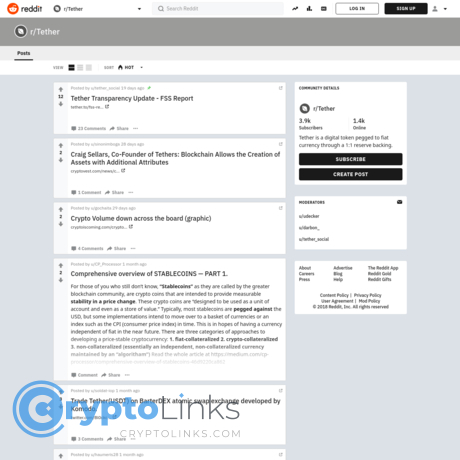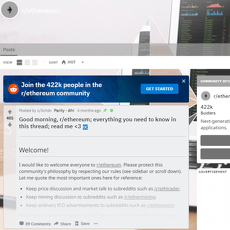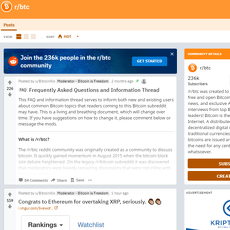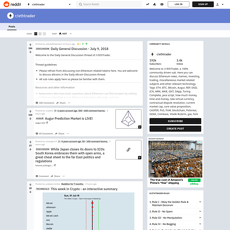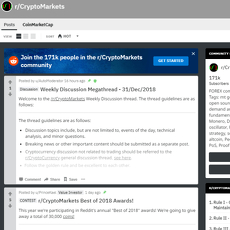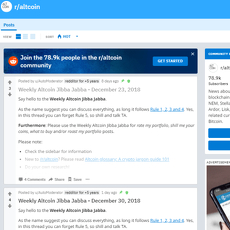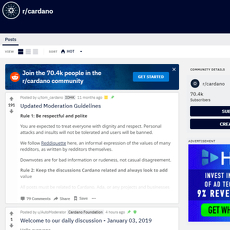r/Tether Review
r/Tether
www.reddit.com
r/Tether Review Guide: Everything You Need to Know + FAQ
Ever scroll r/Tether and wonder, “Is this signal or just a lot of noise?” If you want clear answers about Tether (USDT)—what’s real, what’s hype, and how to use the subreddit without wasting hours—you’re in the right place.
I’ll show you how to get value fast, where the traps are, and which questions r/Tether is great at answering. By the end of this series, you’ll know how to check EU/EEA rules without confusion, verify claims about reserves, and find reliable cash-out routes without chasing random DMs.
Quick promise: Simple workflows, no fluff, and straight answers backed by sources when it matters. If you want anything expanded, drop a comment on cryptolinks.com/news.
The problems r/Tether readers run into
Here’s what trips most people up when they land on the subreddit:
- Too much noise, not enough proof. Hot takes and one-liners drown out good info. This isn’t unique to r/Tether; false or sensational claims spread faster across social media in general. One widely cited study in Science found false news spreads “farther, faster, deeper” than true news (Vosoughi, Roy, Aral, 2018).
- Confusing EU/EEA talk. Threads mix up MiCA rules, platform policies, and national guidance. You’ll see “USDT is banned” next to a user saying “works fine here,” which can both be technically “true” depending on the platform and country.
- Uncertainty about reserves. People post headlines or screenshots without linking to attestations or redemption data. Without sources, you can’t judge how serious a claim is.
- Endless “how do I cash out?” threads. Many posts repeat the same steps but skip key details like fees, limits, or settlement times. That’s how users get clipped by surprise costs.
- Not knowing who to trust. New accounts promise “guaranteed yields” or “secret off-ramps.” If you’ve been on Reddit long enough, you’ve seen how that ends.
To make r/Tether work for you, you need a quick filter for junk, a way to spot credible posts fast, and a plan to verify anything that affects your money.
What you’ll get here
- A clear plan to use r/Tether efficiently. What to read first, how to filter threads, and how to spot red flags in seconds.
- How to verify claims. Simple checks to confirm EU/EEA platform changes, reserve updates, and peg wobbles without guesswork.
- Straight answers to common USDT questions. EU status, cashing out to fiat, why people hold USDT, and realistic earning options—explained in plain language.
- Time-saving habits. Alerts, saved searches, and “trust markers” so you only act on things that matter.
Why this matters: USDT is the most traded asset in crypto by volume on many days, so clarity here affects almost everything you do—on-ramps, off-ramps, swaps, and risk management.
Who this guide is for and how to use it
- Newcomers who want a safe starting point to hold, send, or cash out USDT without stepping on landmines.
- Active traders who need fast checks on exchange policies, chain fees, and market stress without reading 200 comments.
- Long-term holders who want clean risk tips: custody, attestations, peg alerts, and off-ramp backups.
Use it like this:
- Skim the parts you need now; save the rest for later.
- Bookmark the quick checklist near the end of the full guide.
- Ask questions publicly and share sources. If you want extra templates or walkthroughs, say so on cryptolinks.com/news.
Ready to cut the noise and get practical? Up next: what r/Tether is great at, what it isn’t, and how to get oriented fast without missing anything important—want the 2-minute version or the full playbook?
What r/Tether is (and isn’t)
Think of r/Tether as a real-time USDT watchtower: quick news links, exchange policy changes, chain support updates, wallet hiccups, and user Q&A. It’s where you’ll see the first ripples of a story—not the final verdict.
On a typical day you’ll see posts like:
- Exchange updates: “Platform X paused USDT/EUR pairs—what now?”
- Stability chatter: “USDT at 0.997—normal or problem?”
- Wallet/chain support: “Ledger showing TRC20 balance wrong—any fix?”
- How-to basics: “Best route to cash out USDT to bank in [country]?”
But here’s the line I never cross: I don’t act on a Reddit thread without checking the source. When a post mentions a suspension, redemption change, or “official” claim, I confirm via:
- Tether announcements and the transparency page
- On-chain data for the real picture:
USDT on Etherscan,
USDT on Tronscan
- The exchange’s own status page or blog
“In fast markets, seconds count—and sources matter.”
Reddit is fantastic for signal detection, but it’s still social media. Pew Research notes that a large share of Reddit users get news on the platform, but it isn’t evenly vetted across communities (Pew, 2023). And a widely cited MIT study found false news can spread faster than true news on social platforms (Science, 2018). That’s why r/Tether is my early-warning radar—not my final dashboard.
Community vibe and pacing
The rhythm is steady with spikes. Most days, you’ll see short news posts and quick questions. When volatility hits or regulators make noise, threads heat up—fast. Expect:
- Short bursts of headlines linking to exchange notices or press articles
- Weekly-style questions that repeat (“cash out,” “fees,” “which chain?”)
- Panic posts when the peg wobbles even a fraction
- Hidden gems from users who share screenshots of official emails or link to policy pages (these are worth saving)
Emotionally, it can feel like a heart monitor: calm… beep… beep… spike. That’s normal in a stablecoin subreddit. When USDT ticks to 0.998, you’ll see “depeg?” threads, even though it’s within typical intraday variance on some pairs. Breathe, check the top comments, and verify the source before you react.
Rules, flair, and moderation basics
The subreddit is moderated, but quality naturally varies. Knowing the basic house rules makes a big difference:
- Low-effort posts and spam get removed—add context and sources.
- No shilling or referral codes. If someone insists on DMs for “support,” skip it.
- Respect privacy: don’t post wallet addresses or bank info; redact IDs in screenshots.
- Use flairs wisely: look for flairs like “News,” “Discussion,” “Question,” or “Support” to set expectations.
- Report obvious scams and link-bait so mods can act quickly.
Pro tip: scan for mod comments and stickied replies on hot threads. When there’s confusion, mods often add context or direct people to an official link or megathread.
How to get oriented fast
If you don’t want to scroll for an hour, here’s the quick orientation I use when jumping into r/Tether:
- Sort by “Top” (Week/Month) to surface posts that actually helped people.
- Use the search bar for repeat topics like “MiCA,” “cash out,” or “depeg.” You’ll find past discussions that already answer 80% of new questions.
- Filter by flair to isolate “News” or “Support” if you need facts or fixes fast.
- Open two tabs per topic: the thread and the source it cites. If the source is missing or sketchy, move on.
Example: searching “MiCA” often leads to threads where users link their exchange’s EU policy pages and quote the exact wording. That’s way better than guessing based on hearsay.
If you’ve ever wished r/Tether could feel organized instead of chaotic, you’ll like what’s next. Want a 10-minute workflow that filters noise, saves the best contributors, and flags official updates automatically?
Getting real value from r/Tether in 10 minutes
Information overload is real. The trick is turning r/Tether from a time sink into a fast, reliable signal. Here’s the 10-minute routine I use to pull the best from the sub without getting lost.
“The goal isn’t to collect more opinions. It’s to find the one or two pieces of proof that actually change your next move.”
Your 10-minute workflow
- Start with pinned posts: Open r/Tether and read anything pinned. These are usually fresh, mod-curated and include links to official sources or megathreads when news breaks.
- Sort by Top → Month: Scan the top 10 posts for the past month. You’ll quickly see which topics repeatedly matter (MiCA updates, exchange policy changes, depeg chatter, chain fees).
- Save high-signal users: When you see a comment that cites official docs, on-chain txs, or exchange announcements, tap Save on the user’s profile or post. Look for:
- Accounts older than a year with a consistent history in crypto subs
- Links to sources (Tether transparency, exchange status pages, block explorers)
- No DMs for “support” and no referral spam
- Set alerts on key searches: Search for “USDT official”, “MiCA”, “depeg”, or your exchange name + “USDT”. On Reddit mobile/web, create a search alert (or use site:reddit.com with Google and set an alert there). This way, you get pinged when something important lands.
Must-check threads and stickies
When big stuff happens, mods or power users often bundle everything into one “megathread” or sticky. These are gold because they collect the highest-quality links and save you from chasing rumors.
- Regulatory shifts (EU/EEA): After MiCA stablecoin rules kicked in during 2024, some EU platforms adjusted or restricted USDT features. Look for megathreads titled along the lines of “MiCA stablecoin changes” or “EU USDT policy updates.” They typically include links to platform notices and timelines.
- Exchange policy changes: Deposits/withdrawals paused, wallet maintenance, or chain-specific support moves (e.g., Tron vs Ethereum). Megathreads usually summarize which regions and rails are affected and for how long.
- Chain incidents/bridge scares: If a bridge gets congested or an exploit rumor floats around, stickies often list verifiable txs, status dashboards, and official statements. Read these before reacting to screenshots.
Quick reality check: false or sensational claims spread fast. A widely cited study in Science (2018) found false news travels faster and further than true news. That’s why stickies and megathreads that bundle verifiable sources save you.
Smart search queries to try
Use the subreddit’s search. If results feel thin, use Google with site:reddit.com/r/Tether plus your keywords.
- “USDT EU MiCA” — surfaces policy changes, platform-specific restrictions, and user experiences in the EEA
- “USDT cash out bank” — recent routes people used, fees, limits, and KYC hiccups
- “USDT attestations” — latest discussion threads linking to Tether’s reports and commentary on composition/liquidity
- “USDT on Tron vs Ethereum fees” — practical comparisons, confirmation times, and exchange support patterns
- “USDT depeg history” — timelines of past wobbles with charts, order books, and how long it took to normalize
Pro tip: add your exchange name and country (e.g., “USDT cash out Germany SEPA” or “USDT withdrawal US wires”) for region-specific advice.
Red flags (how to avoid wasting time or getting burned)
- Unverified screenshots: If someone posts a cropped image of a support chat, an “internal” email, or a balance, assume it’s noise until you can confirm. Look for exchange status pages, official Twitter/X handles, or block explorer links that match the claim.
- Fixed-income “guarantees”: Any post promising 2% per day or “risk-free” USDT lending is marketing at best and a scam at worst. Real yields reflect real risks. If you can’t name the borrower and the collateral, pass.
- Unsolicited DMs: Scammers love to “help” with withdrawals or “unlock frozen USDT.” No legit support operates via Reddit DMs. Keep help requests public and tag mods when needed.
- Brand-new accounts with secret methods: The classic “I found a loophole to cash out USDT” or “EU ban bypass” post is bait. Check account age, post history, and whether anyone reputable backs it with proof.
Fast sanity run when a depeg rumor hits
- Check USDT quotes on multiple venues: spot USDT-USD on a major exchange and a stablecoin aggregator
- Glance at depth: does the order book show thin bids under $1.00 or is liquidity normal?
- Open Tether’s transparency page and recent attestations for context
- Scan r/Tether for a sticky or a post with links to official statements and on-chain txs
- If unsure, test a small redemption path you already trust (exchange or fiat ramp) and see if it clears fast
How I spot trustworthy comments fast
- They link to official notices, explorers (Etherscan/Tronscan), or status pages
- They admit uncertainty and give a plan (e.g., “set a $0.995 alert and test a small withdrawal”)
- They don’t push DMs, paid groups, or mystery PDFs
- They’re consistent across multiple posts and timeframes, not just this week’s hot topic
Real-world example: You read “EU banned USDT” in a heated comment thread. Before reacting:
1) Search r/Tether for “MiCA USDT” and open the latest high-upvote thread.
2) Check linked platform notices to see what’s actually restricted (issuance, marketing, or certain rails).
3) Look for users reporting successful cash outs in your country during the same week—verify with screenshots + bank redactions + timestamps, and cross-check with platform status pages.
You’ve got the workflow. Now, the big questions are next: Is Tether actually banned anywhere? What’s the cleanest way to cash out USDT without getting hammered by fees? And why do traders keep piling into USDT even in choppy markets? Keep scrolling—those answers are coming up right away.
FAQ: Straight answers to the biggest Tether questions
“Why is Tether banned?”
Short answer: It isn’t broadly “banned.” What’s happening is that EU/EEA rules under MiCA put tighter requirements on how stablecoins are offered, so some platforms in Europe have restricted or relabeled USDT while they adapt. That can look like fewer trading pairs for EEA users, “unauthorized stablecoin” warnings, or nudges toward EU-registered alternatives.
Key points to understand
- MiCA compliance window: Certain stablecoin rules started rolling out in 2024–2025. Until an issuer is fully under that framework in the EU, some platforms limit retail features to stay safe on the regulatory side. Source: EU Regulation 2023/1114 (MiCA).
- Country and platform differences: Your experience depends on your location and which exchange you use. One EEA exchange might keep USDT spot trading but restrict promotions; another could remove certain pairs for new users while allowing withdrawals.
- Not a global prohibition: Outside the EEA, most platforms operate USDT as usual. Even within the EEA, you’ll typically still be able to withdraw or convert — it’s the front-end availability and labeling that often change first.
What to do if you hit a “restricted” message
- Check whether deposits/withdrawals still work for your preferred chain (TRON, Ethereum, etc.).
- See if your platform offers a compliant fiat ramp (SEPA/ACH) after a swap from USDT to EUR/USD.
- If spot pairs are limited, you can often route through a liquid pair (e.g., USDT → USDC/USDe/EUR stable → EUR) before withdrawing.
“Regulation changes UX before it changes fundamentals — plan your routes and you’ll be fine.”
“Can I convert my USDT to cash?”
Yes — and you’ve got multiple routes. The trick is matching your KYC level, your bank’s tolerance, and fees/timelines.
Common paths
- Centralized exchange
- Verify KYC, deposit USDT on the chain your exchange supports (match TRC20 vs. ERC20 exactly).
- Trade USDT → fiat (USD/EUR/GBP). Stick to deep-liquidity pairs for better pricing.
- Withdraw via bank rails: SEPA in the EU (often same-day or next business day), ACH/wire in the US, Faster Payments in the UK. Fees vary by exchange and rail.
- P2P marketplaces (escrow-based)
- Filter by currency and payment method (local bank transfer is common).
- Only release USDT after the bank transfer clears on your end. Never accept “proof” screenshots.
- Use established platforms with strong dispute systems (e.g., major exchange P2P desks).
- OTC/brokers (larger amounts)
- Good for $25k–$1M+ where you want clean settlement, receipt, and custom fees.
- Insist on written terms, confirm banking corridors, and test a smaller tranche first.
- Crypto debit cards
- Load through a supported exchange/app and spend in-store or withdraw at ATMs.
- Check card availability in your country and any daily ATM caps or FX mark-ups.
Pro tips
- Start with a small test (e.g., $50–$200) to confirm fees, timing, and name matching on bank receipts.
- Break large withdrawals into chunks to avoid triggering bank reviews.
- Keep clean records (amount, timestamps, tx hash, exchange receipts) for taxes and compliance.
“Why is everyone buying Tethers?”
Because USDT is a fast, liquid way to hold and move dollar value. It’s not about “betting on Tether” — it’s about parking in dollars without leaving crypto rails.
Real-world reasons I see daily
- Currency pressure: In places like Argentina, Nigeria, or Türkiye, USDT offers dollar exposure when local currency is volatile.
- Liquidity everywhere: USDT pairs exist on nearly every exchange and most chains, so moving between coins or venues is quick.
- Settlement speed: On TRON or Ethereum, settlement can be minutes — useful for arbitrage, paying suppliers, or payroll.
- Trading stack: Traders hedge, rotate, and manage risk in USDT between positions rather than wiring in/out fiat constantly.
Data that backs this up
- Stablecoins have dominated on-chain transfer volume since 2022–2024; USDT consistently leads by market share. See Chainalysis’ regional reports: Chainalysis blog.
- USDT is the quote asset for a large slice of centralized exchange trading volume according to market structure research from Kaiko: Kaiko Research.
“In uncertain economies, people don’t chase yield — they chase stability.”
“How do people make money with Tether?”
USDT itself doesn’t “go up.” People earn by putting it to work — which always introduces risk. If you can’t explain the risk in a sentence, you probably shouldn’t touch the yield.
Common approaches
- CeFi lending
- Platforms lend your USDT to traders/market-makers and pay you a variable APY.
- Risk: counterparty failure. Remember 2022: high yields didn’t protect anyone when lenders collapsed.
- Reality check: In a 5% treasury world, “safe” double-digit yields are suspicious. Ask who borrows, how they’re collateralized, and what happens if they default.
- DeFi lending and stable pools
- Protocols like Aave, Compound, and stable pools on Curve/Velodrome/Curve-like forks pay variable APY plus incentives.
- Risks: smart contract bugs, oracle failures, depeg risk if a pool becomes unbalanced, and bridge risks on L2s.
- Mitigation: prefer audited, battle-tested protocols; spread across chains; monitor pool composition and utilization ratios.
- Funding-rate or basis trades (advanced)
- Hold USDT, buy spot coin, short perpetual futures; clip the funding or basis.
- Risks: exchange risk, execution errors, funding flips negative, and sudden volatility that widens spreads.
- Short-term parking
- Some traders simply keep USDT between moves to avoid coin volatility and earn a small, flexible yield on reputable venues.
Rules I live by
- Never hand USDT to anyone promising fixed returns with no transparency or collateral.
- Use multiple platforms rather than one bucket. Small frictions beat catastrophic losses.
- Keep an “emergency exit” ready: one self-custody wallet, one exchange you trust, and one fiat rail that’s tested.
“Your yield is someone else’s leverage — know who owes you.”
If yield is the upside, risk management is the downside protection. So what happens if USDT wobbles off $1, or your exchange stalls withdrawals? Up next, I’m walking through a fast, no-panic plan for custody, reserves, and depeg readiness — including the exact alerts and tests I run before the crowd notices.
Safety, reserves, and depeg readiness
I treat r/Tether like an early-warning radar. When something looks off, I check the thread—but I act only after confirming with official data and market metrics I trust.
“Trust is good; verification is better.”
If you’ve ever watched USDT tick to $0.985 and felt that knot in your stomach, this section is your calm plan. Here’s how I stay safe, verify reserves, and get ready for the rare—but real—moments when the peg wobbles.
Custody and exchange risk
I split this into two buckets: on/off-ramps for speed, and self-custody for safety. Both matter.
- On/off-ramps: Keep verified accounts on 2+ reputable exchanges. Enable 2FA (preferably with a hardware security key), turn on withdrawal address allowlists, set an anti-phishing code, and require email + device confirmation for withdrawals. If an exchange pauses fiat rails during stress, you’ll be glad you have a second option.
- Self-custody for larger balances: Use a hardware wallet for long-term storage. Label your addresses. Send a small test before any large move. Keep a tiny amount of native gas on each chain you use (ETH on Ethereum, TRX on Tron, etc.) so you’re never stuck.
- Verify token contracts—never guess: On Ethereum, the official USDT address is
0xdAC17F958D2ee523a2206206994597C13D831ec7
. On other networks, always cross-check via Tether’s site:
tether.to/transparency.
Copying a contract from a random post is how people lose money.
- Know the network specifics: USDT exists on multiple chains (Ethereum, Tron, Solana, etc.). Match the deposit network exactly on both sides. Some exchanges restrict certain networks regionally, especially post-regulatory changes—double-check before you move.
- Legacy cleanup: Tether discontinued Omni and some older transports in 2023. If you still hold “stranded” variants, plan a migration using the exchange or chain they support today.
Real-world note: during volatile news, exchanges sometimes switch wallets to maintenance, increase fees, or add extra checks. This isn’t a conspiracy; it’s operational load. Your backup ramp is your safety net.
Reserves and attestations
There’s a difference between a headline and a balance sheet. I watch three things: what Tether reports, how redemptions behave under stress, and what market prices say across venues.
- Attestations (not audits): Tether publishes quarterly attestations by BDO that summarize reserve composition and excess reserves. Start here:
Tether Transparency and the attestations section:
BDO Reports.
You’ll typically see a majority in short-term U.S. Treasuries and cash-equivalents, plus positions in Bitcoin and gold, and notes about secured loans.
- Redemption behavior matters: In May 2022, when USDT briefly traded below $1 on some venues, Tether said it honored roughly $7B in redemptions within 48 hours (and about $10B in the following days). Watching how quickly supply contracts under stress is one of the best reality checks you can do.
- Where redemptions actually happen: Most users don’t redeem with Tether directly (that route needs full verification and specific thresholds). Instead, exchanges and OTC desks aggregate client flows and tap Tether’s redemption lines. If you need fiat, your exchange’s USD/EUR rails are usually faster than going straight to the issuer.
- Market signals worth tracking:
- USDT/USD order books on deep venues (e.g., Kraken, Bitfinex). If USDT prints $0.98 on multiple liquid markets with thin bids, that’s real signal—not just a single exchange glitch.
- Stablecoin pools like Curve’s 3pool balance split. A heavy skew toward USDT can flag short-term pressure. Don’t panic—just confirm with other data.
- Cross-exchange dispersion: Kaiko and similar research shops have documented several short-lived USDT dislocations in 2022–2023 that normalized as liquidity rotated. A quick scan of Kaiko Research gives you historical context for what’s “normal stress.”
Regulators are watching this space too. The BIS has warned that stablecoin design and reserve quality are key to resilience—worth a skim if you like the big-picture view:
BIS Bulletin on Stablecoins.
Your depeg checklist
I run this playbook so I don’t have to think when the chart gets loud:
- Set alerts at 0.995 and 1.005 across at least two sources (e.g., TradingView + CoinGecko app). One feed can lag or fail when volumes spike.
- Map your exits ahead of time:
- Primary: Convert USDT to fiat on your main exchange and withdraw via your preferred rail (SEPA/ACH/wire). Test a small cash-out monthly so you know timings and fees.
- Secondary: USDT → USDC/fiat on a backup exchange with verified KYC. Keep both accounts funded with a few dollars of network gas.
- Tertiary: OTC or P2P with escrow. Only for experienced users—verify identity, settle in-branch or via instant rails, and never release funds before confirmed receipt.
- Know your “fast lanes” by chain and region: Tron and Solana are quick and cheap; Ethereum is the most widely supported. In some EU/EEA platforms under MiCA alignment, certain USDT routes are restricted—check your platform’s live status before you move.
- Watch liquidity, not just price: If spreads widen and order books get thin, slippage becomes your main cost. In that case, prefer fiat books (USDT/USD, USDT/EUR) on high-volume venues over AMM pools.
- Pre-commit your rules:
- Mild kink (0.995–0.999): Monitor, maybe swap a portion to USD/USDC if depth looks weak.
- Persistent sub-0.99 across venues: Execute the plan—convert to fiat or your chosen hedge on your best-liquidity venue. No hesitating, no “one more refresh.”
- Network chaos or paused rails: Use your backup exchange. If both are degraded, reduce size and accept higher fees—capital preservation first.
I also keep a small “test withdrawal” amount already sitting on my bank’s side. When stress hits, I can immediately compare real settlement times instead of guessing.
Tax and compliance quick note
- Yes, swaps can be taxable: In many places, converting USDT to another asset (even USDC) is a taxable event. Log timestamps, prices, fees, and transaction hashes.
- Export everything: Download CSVs from exchanges every month and back them up. For self-custody, keep your explorer links (Etherscan/Tronscan/Solscan) and label transfers.
- Expect source-of-funds questions: Banks and fintechs may ask for documentation during larger withdrawals. Keep screenshots of trades, deposit TXIDs, and exchange receipts in one folder.
- EU readers: Platforms are implementing MiCA at different speeds. If your exchange changes stablecoin policies, they’ll usually announce it—save those notices for your records.
Here’s the emotional truth: panic sells low and buys high. Plans do the opposite. When the feed gets noisy, I lean on the data above and execute the checklist—no drama, just steps.
Want the exact dashboards, explorers, and peg trackers I rely on day-to-day so you can set this up in minutes, not hours?
Helpful tools, alternatives, and how r/Tether fits into your stack
I treat r/Tether as my sentiment and “early ping” channel, then I confirm everything with data. Here’s the exact stack I use so I’m never guessing about USDT’s peg, liquidity, or my exit routes.
Complementary places to watch
- Official sources
- Tether Transparency – current reserves breakdown, supply by chain, and attestation links.
- Tether Blog – redemptions, chain support changes, and policy notes. When UST imploded in May 2022 and USDT briefly printed ~0.95 on some venues, the blog and transparency page helped verify multi‑billion dollar redemptions were being processed and supply was contracting accordingly.
- Exchange status pages (critical during maintenance or bank holidays)
- Kraken Status, Coinbase Status, Binance Announcements, OKX Status, Bitfinex Status. If withdrawals are disabled on one platform, don’t assume “USDT is broken”—it’s often a venue issue.
- Other Reddit subs for cross-checks
- r/CryptoCurrency – wide coverage; useful for macro headlines and exchange incidents.
- r/StableCoins – comparative discussions on USDT, USDC, DAI, and liquidity conditions.
- r/ethfinance – on-chain nuance, especially for Ethereum-based USDT flows.
Why cross-check? In stress windows (May 2022; March 2023), single feeds can exaggerate swings. Broad sources help you separate a venue-specific hiccup from a system-wide issue, and they often surface the first credible links you need.
Tools that save time
- Block explorers to confirm reality
- Etherscan (ERC‑20 USDT) – verify contract address, track large transfers, check your tx status.
- Tronscan (TRC‑20 USDT) – fastest confirmations and lowest fees for many users; always confirm recipient address and chain.
- Solscan (SPL USDT) – for Solana-based flows.
- Stablecoin peg and supply trackers
- DeFiLlama Stablecoins – market cap by asset and chain; handy to confirm redemptions or new issuance trends.
- CoinGecko USDT and CoinMarketCap USDT – quick peg snapshots across exchanges; set watchlists and alert thresholds.
- Alerting that actually works
- TradingView – set USDT/USD or USDT/EUR alerts at 0.995 and 1.005 on the venues you use.
- IFTTT or Zapier – push new posts from Tether’s blog and your main exchange status feed to Telegram/Email.
- @Tether_to and @paoloardoino on X – good for real-time operational notes (issuance, redemptions, chain pauses).
- Rate and fee comparison for exits
- WithdrawalFees.com – sanity-check crypto and fiat withdrawal costs across exchanges.
- P2P rails: compare spreads on your exchange’s P2P board (e.g., Binance P2P) with reputable OTC brokers; a 0.3–0.8% faster route can matter during stress.
Sample workflow: If you see a “USDT depeg” thread on r/Tether, check DeFiLlama for same-day supply changes, compare USDT quotes on 2–3 big venues via CoinGecko, and verify any “suspension” claims on the relevant exchange’s status page. During the May 2022 shock, this exact triage made it obvious that redemptions were happening at scale and order books were normalizing within hours on top venues.
How I combine r/Tether with data (so it actually helps)
- Use Reddit for the spark, not the verdict. Scan r/Tether for the first signal (policy changes, exchange maintenance, chain hiccups). Save high-signal users who link sources.
- Confirm on-chain and venue-side. One explorer check for your tx, one peg check across two venues, one status page check. Three clicks beat 300 comments.
- Keep a pre-tested exit. Have one CeFi off-ramp and one P2P/OTC route tested with a small amount. If you need to rotate to USDC or to fiat, you’ll know the speed and the fees ahead of time.
- Log material events. A simple note: timestamp, venue, price deviation, links. Over time, you’ll see which sources called it right and which ones were noise.
Pro tip: Build a mini “peg board” in TradingView with USDT/USD on your main exchange, USDT/EUR on a European venue, and USDT/USDC on a deep book. If USDT/USDC widens while USD and EUR pairs look normal, it’s likely a venue-specific liquidity imbalance, not a broad depeg.
Want my exact 10-minute alert setup and a copy/paste checklist you can run the next time r/Tether goes into “is USDT off-peg?” mode? That’s next—ready to set it up once and forget it?
Your quick-start plan and final tips
If you want r/Tether to work for you (not the other way around), set it up once, keep it tight, and verify anything that could cost you money. Here’s the exact playbook I use.
10-minute setup
- Tune your feed: Subscribe to r/Tether, sort by Top → Month, and read the pinned posts. That gets you the highest-signal threads and any current notices.
- Save signal sources: Bookmark the latest posts with Official or Announcement flair and save 2–3 users who consistently share links and evidence (history > 1 year, active comment sections, no referral spam). You can unsave later if they start posting fluff.
- Set price alerts for wobble thresholds: Most drama starts when the peg drifts. On TradingView, add an alert for USDT/USD at 0.995 and 1.005. Why those numbers? They catch mild dislocations without pinging you all day. For context, USDT printed around $0.95 on some venues in May 2022 (source), while USDC hit ~$0.88 in March 2023 (source). Alerts buy you time.
- Create two news alerts:
- Google Alerts for USDT + MiCA + your country’s name: google.com/alerts
- Reddit RSS for keyword posts in r/Tether (example for “MiCA”): search.rss?q=MiCA
- Bookmark the sources that actually matter:
- Tether Transparency (attestations, composition, liquidity notes)
- Tether Blog (official announcements)
- Your exchange status pages (e.g., Kraken, Coinbase, Binance)
- EU MiCA reference page: Regulation (EU) 2023/1114
- Write a 30‑second exit note: In your phone notes, list:
- Your primary off‑ramp (exchange + fiat method + limits)
- Your backup off‑ramp (P2P/OTC or a second exchange)
- Your fastest chain in practice (e.g., “Tron for speed, ETH for liquidity”) and the fee you last paid
- One alternate stable you trust in a pinch
Then run a $20 test withdrawal to your bank or card. If it fails, fix it now—not during a depeg.
Posting etiquette and getting help
- Search first: Use exact quotes and flair filters. Example: “cash out” flair:Question, “MiCA” site:reddit.com/r/Tether. You’ll find answers faster and avoid duplicate threads.
- Share enough context to get real help: exchange, chain, country/region, ballpark amount, and timeframe. Include first 6/last 4 of TXID if relevant. Mask addresses, no QR codes, no full screenshots with personal info.
- Never accept support via DMs. This is how most “agent” scams start. Reddit’s own guidance warns against this behavior (source), and crypto-crime reports repeatedly highlight social engineering as a leading vector (Chainalysis).
- Ask publicly, tag mods if needed: If someone offers a fix, request sources. For anything urgent or suspicious, hit Report and drop a note to the mod team.
- Avoid absolutes: If you’re giving advice, say how you verified it (link to docs, explorer, status page). Claims without receipts waste everyone’s time.
- Use this mini-template for faster answers:
Title: [Cash out][EU] Bank wire from Exchange X stuck 48h after selling USDT
Body: Country: DE | Exchange: X | Chain: ETH | Amount: mid four figures | What I tried: opened ticket, checked status page (all green), TXID suffix ...9f2a | Question: do EU wires from X usually take 2–3 business days?
Links: status page, explorer, any official announcement
Keep the signal, cut the stress
I use r/Tether for pulse checks and edge cases, then confirm anything important through official pages or market data. That balance keeps me fast without being reckless.
- Weekly 3-minute maintenance: skim Top (Week), confirm your alerts still work, and re-run a $20 withdrawal if your bank/exchange changed policies.
- When the peg wiggles: check two venues, look at liquidity on your main pair, and read the latest official post before acting. If your alert hits 0.995, you’re early—not late.
- Document everything that touches fiat: timestamps, values, fees. You’ll thank yourself at tax time.
“If you can’t explain your exit route in 30 seconds, you don’t have one.”
If you want ready-made checklists, alert presets, or a walkthrough for your exchange/region, tell me what you need on cryptolinks.com and I’ll build it. Stay curious, verify everything, and keep your off‑ramps tested.

